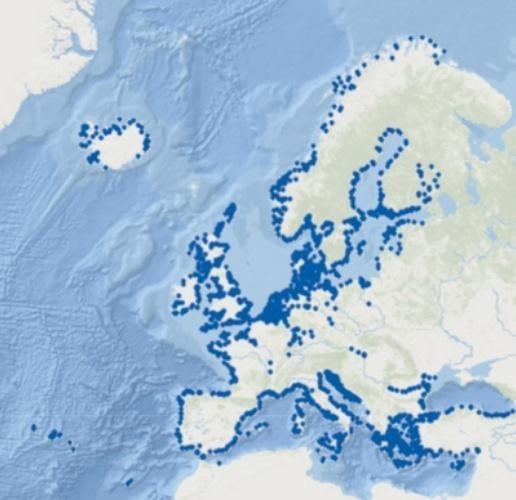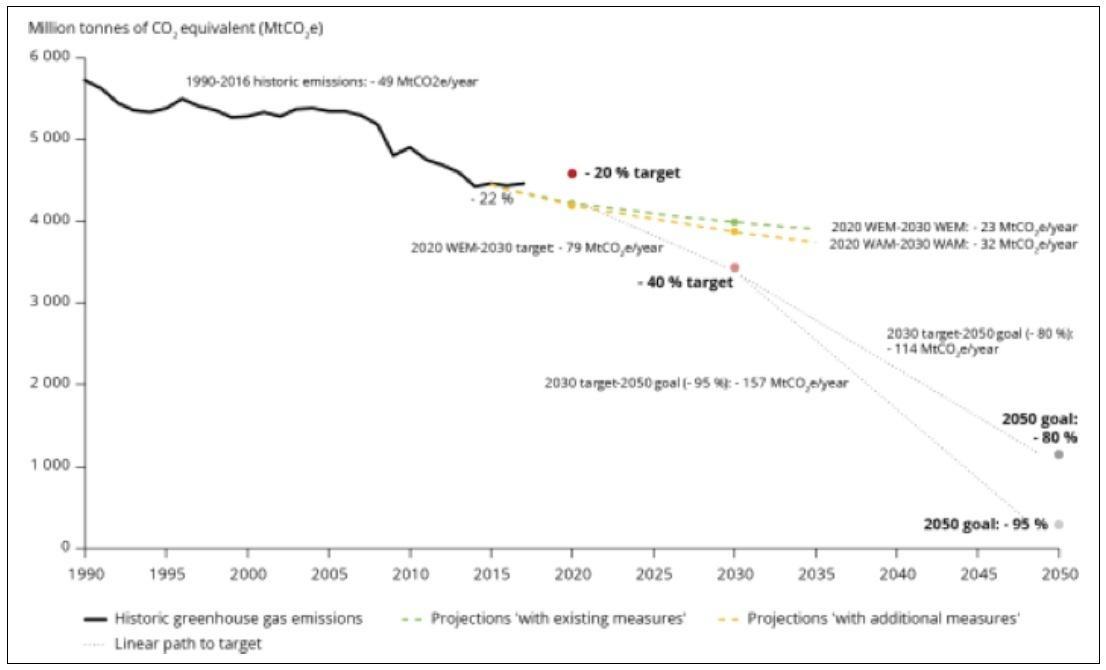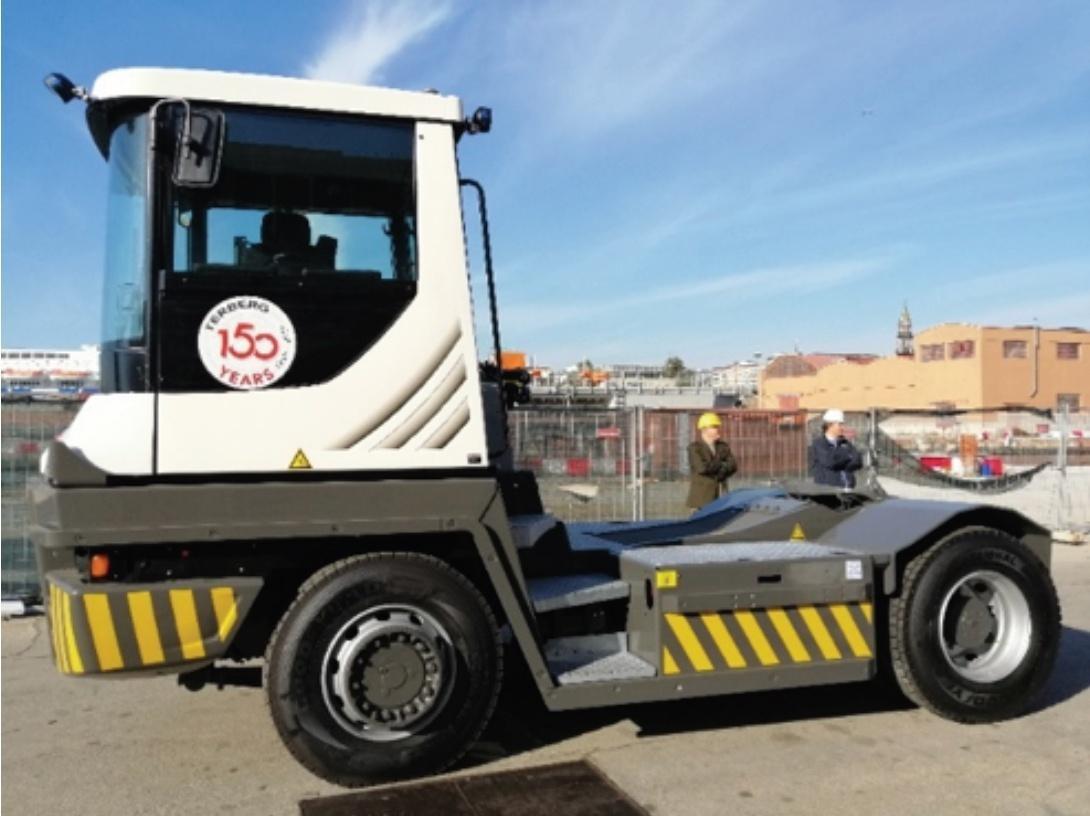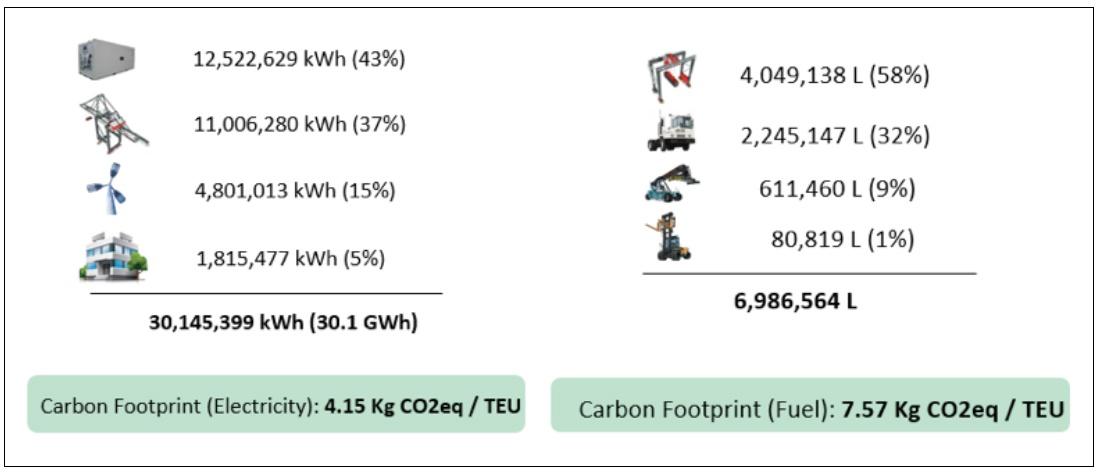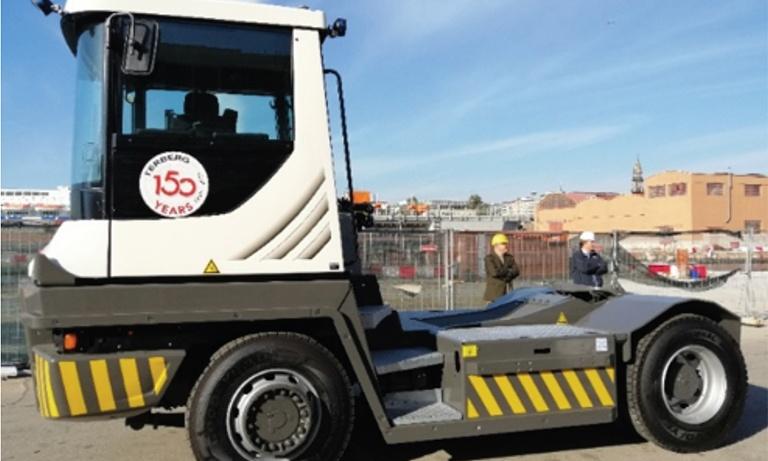
The role of hydrogen in European port ecosystems
DOI 10.12910/EAI2021-027
by Viviana Cigolotti, Energy Storage, Batteries and Hydrogen Production and Utilisation Technologies Laboratory
Ports can play a pivotal role in the world’s decarbonisation challenge as natural hubs for sector coupling and energy system integration. They could become the frontrunners of the energy transition, if port authorities and industry sectors join forces. Hydrogen technologies and fuel cell technologies can help ports to reduce pollution and increase operational efficiency in all the sectors involved. Consequently, these innovative technologies have generated considerable interest from ports around the world, even though the actual experiences carried out so far are very few but effectively increasing. ENEA is actively involved in H2Ports project (www.h2ports.eu) as linked third party of ATENA Scarl, facing with the first European application of hydrogen technologies in port handling equipment: the main activities are focused on the prototyping, piloting and deployment fuel cell equipment for non-road applications into real port operations. H2Ports aims to boost the transition of the European port industry towards an effective low- carbon/zero-emission and safe operative model, by piloting, evaluating and demonstrating new fuel cell technologies oriented to increase energy efficiency, decarbonisation and safety of port terminals.
I porti possono svolgere un ruolo fondamentale nella sfida mondiale della decarbonizzazione, essendo degli hub reali dove poter dimostrare con successo il concetto di sector coupling e dell’integrazione del sistema energetico. Le tecnologie dell'idrogeno e delle celle a combustibile possono dare un contributo fondamentale per ridurre l'inquinamento e aumentare l'efficienza di tutti i settori che operano in ambiente portuale. Questi sistemi innovativi hanno riscosso un notevole interesse da parte degli operatori del settore portuale di tutto il mondo, anche se ad oggi esistono poche esperienze concrete svolte. L'ENEA è attivamente coinvolta nel progetto H2Ports (www.h2ports.eu) come terza parte di ATENA Scarl; il progetto ha l’obiettivo di dimostrare la prima applicazione europea delle tecnologie dell'idrogeno nei mezzi utilizzati per la movimentazione delle merci in ambito portuale; le attività principali sono focalizzate sulla prototipazione, implementazione e testing di mezzi con celle a combustibile utilizzate per operazioni portuali. H2Ports mira a promuovere la transizione dell'industria portuale europea verso un modello operativo efficace ed a basse emissioni di carbonio, dimostrando la fattibilità di nuove tecnologie delle celle a combustibile orientate ad aumentare l'efficienza energetica, la decarbonizzazione e la sicurezza dei terminal portuali.
The European Union counts in total over 1400 ports (fig.1) and has many direct connections with about 850 ports in the Far East and almost 600 ports in South and Central America. In total, these ports cover the handling of 3.6 billion tons of freight and 410 million passengers (2018 data). The average CO2 emissions in EU ports, both taking into account emissions under control of the Port Authority (such as buildings, lighting, OPS services, etc.) and those from external partners operating in the port (companies, ship owners and operators, port handling activities operators, etc.), count for about 150 kton per year, thus reaching a total emission by the 1400 EU ports of 210 Mton per year. This means that about 4.7% of the total CO2 emissions (4.500 Mton, fig.2) in Europe are directly linked to emissions in and by the ports.
A real transition in the area of ports from fossil fuel based energy use towards energy vectors based on Renewable Energy Sources (RES) is needed and will have a relevant impact, given that waterborne transport is responsible for about 13% of all EU transport GHG emissions. In addition, since waterborne transport accounts for about 90% of global trade, the importance to help this sector to initiate its transition towards zero emission waterborne transport will bring positive impacts on climate change.
Hydrogen and fuel cell technologies have proven their performance in several applications, including buses, trucks, cars, forklifts and even passenger trains. Differently, the use of hydrogen-powered fuel cells for ship propulsion is still at an early design or trial phase with applications in smaller passenger ships, ferries or recreational crafts. The use of hydrogen shows great promises in decreasing ship-generated carbon emissions.
Making the transition to a new energy source is a major challenge. In the case of fuel cells for marine vessels, the main hurdles are in the refuelling infrastructure and hydrogen availability in ports. Before operators can power their vessels using fuel cells, hydrogen supply and fuelling infrastructure needs to be further developed. In the nearer timeframe, hybrid battery/fuel cell applications are viable for certain type of vessels, such as ferries, cruise and river vessels.
Research and development activities in ENEA
ENEA is actively involved in H2Ports project (www.h2ports.eu), facing with the first European application of hydrogen technologies in port handling equipment. ENEA is participating to this European project funded by FCH JU as partner of ATENA scarl (www.atenaweb.com) a Research and Technology Hub for Energy and Environment composed of Universities, Research Institutes, and Private Companies mainly based in Campania Region.
H2Ports’ main activities are focused on the prototyping, piloting and deployment fuel cell equipment for non-road applications into real port operations. This project will demonstrate and validate in real port environment two innovative solutions based on FC technologies and a hydrogen mobile supply station specifically designed for the project, at the Port of Valencia. A Reach Stacker to be tested in MSC Terminal Valencia and a Yard Tractor to be tested in Valencia Terminal Europa (part of Grimaldi’s group) have been selected as those specifically fitted to the use of hydrogen in port facilities. The project will run the equipment on a daily basis during two years of real operational activities and will analyse ways of improving the energy efficiency, performance and safety of operations with Fuel Cells port equipment. The project will also take into account transversal issues such as the social acceptance, regulation, future roll out of the technology on a full commercial basis, and the raise of awareness of the potential of hydrogen adoption as an alternative fuel in ports.
H2Ports aims to boost the transition of the European port industry towards an effective low- carbon/zero-emission and safe operative model, by piloting, evaluating and demonstrating new FC technologies oriented to increase energy efficiency, decarbonisation and safety of port terminals. The main objective of the project is to provide ports with FC technologies and hydrogen use as zero-emission fuel through innovative solutions to be ready for market deployment by the end of the project.
As starting point, H2Ports will take on-going developments that reference port equipment manufacturers have been developing in the last years. These prototypes implement eco-efficient technologies able to reduce the carbon footprint of European ports, which are responsible for a major share of GHG and pollutant emissions generated by the use of diesel powered heavy-duty machinery in 24/7 cycles.
ATENA, together with its members involved in this project (ENEA, University of Naples Parthenope, University of Salerno and Cantieri del Mediterraneo spa) is responsible for developing, realizing and testing a FC Yard Truck in a real-life operation site with the aim of decarbonising port areas (fig.3). The FC Yard Truck will be tested by Grimaldi Group in its Valencia Terminal Europe, Spain.
ATENA selected a hybrid power unit architecture to develop the no-emission Yard Truck based on a Plug-in Fuel Cell Electric Vehicle platform.
The main objective of ATENA and its members activities in H2Ports project are related to:
- Introducing a clean energy solution for port operations within ships, as Yard Truck need to load/unload cars to/from ship car carriers;
- Diversifying the energy options for the port-logistic sector in order to reduce its dependency from fossil fuels;
- Deploying in the market a comprehensive set of low carbon and eco-efficient equipment for European Port Ro-Ro Terminals;
- Developing a commercial strategy and business plans for the market roll-out of the proposed solutions;
- Defining recommendations, best practices and policies based on the project results to ensure effective roll-out along EU ports.
H2Ports will facilitate the generation of significant impacts on the European port-logistic industry, a sector where application of hydrogen and fuel cell technologies to port-equipment and non-road machinery is currently inexistent in real operation environments. Moreover, H2Ports will bridge the existing gaps between research development and industrial application in this strategic sector, thus contributing to implement and deploy clean and low-carbon technologies in the port-logistic sector.
Projects and perspectives
Maritime transport and its logistic infrastructures (maritime ports, inland waterways, logistics platforms, etc.) are essential to keep the European Union in the leading position of world-developed areas. The impact of this strategic sector in the quality of life of European citizens and in the EU competitiveness is crucial, as maritime transport and the port sector is a powerful key driver for job creation and economic welfare. Promoting innovation on efficiency and sustainability of seaports is a fundamental issue.
The significant economic growth before the global financial crisis and the increase of foreign trade cargo volumes have driven maritime ports into increasing their capacities from all perspectives.
Infrastructures, services and related equipment have achieved a significant development of capabilities and complexity. This evolution has provided remarkable benefits for the performance of port logistics.
However, important negative effects like operational inefficiencies remain, resulting in increased energy consumption, Greenhouse Gas (GHG) and pollutant emissions among other externalities due to the intensive use of fossil fuels.
These facts reflected on the “EU Freight Transport Logistics Action Plan” and on the “European Ports Policy Communication” still remain valid:
- Congestion in some parts of the European transport system is negatively affecting costs and time of transport and increasing fuel consumption. Freight transport needs to provide its contribution in addressing the EU's climate change targets and reducing pollutant emissions and noise.
- Freight transport is highly dependent on fossil fuels, a large proportion of them being imported.
- A major technological change marked by the development of container transport, more effective, faster, safer, and cleaner in technology and social issues is required from ports and the cities hosting them.
In the port sector, more than 250 container terminals are currently operating in European countries.
More than 100 million TEUs (Twenty-Foot Equivalent Unit), were overall handled in 2017 in European seaports, resulting in the generation of approximately 1.3 million of CO2 emission tonnes per year.
This amount of GHG emissions is not included in the EU Emissions Trading System, generating remarkable external costs and it is not properly accounted for the impact on European economy and citizens’ quality of life.
High environmental footprints
Facilitating the transition of the existing European port terminals towards low carbon and zero local emissions operative models is a challenging goal that should be promoted with the aim of achieving Europe’s 20/20/20 objectives.
Urban air quality, noise pollution and their associated impacts continue to rise up the political and public agenda, with an increasing number of cities and regions pushing for an outright ban on the use of fossil fuels and the promotion of cleaner alternatives. Whilst some see this just as a first step pushing to a low or zero emission urban economy, it is important to take into account all the potential sources of pollutants. In this scenario, the port is a non-negligible actor.
Port facilities are typically located near cities or residential areas, having environmental impact in terms of air and water quality, noise and emissions. To meet regulatory requirements for urban air quality and the establishment of low emission zones within port cities increasingly requires to address emissions from heavy duty port applications in addition to road transport.
The environmental footprints from ports that are close to urban centres are high, not only due to shipping with large diesel engines, but also due to the large number of machineries, vehicles and cranes that move goods within a port. Emissions from port container operations associated with electric power are estimated to contribute approximately 10% of the total port GHG emissions (CO2) while emission caused by road transport within port areas typically accounts for up to 30%, with the remaining majority of emissions caused by ships generators. Concerning port operations, rubber tired gantry cranes, yard trucks and material handling vehicles dominate fuel consumption (fig. 4).
Some projects supporting the deployment of battery electric vehicles or LNG fuelled vehicles have proven effectiveness to reduce fuel consumption and to enhance port operation. With increasing focus on both local and global emissions, zero emission solutions able to increase current battery electric propulsion technology or cable reel electric supply are required. For such applications, the suitability and viability of hydrogen and fuel cell technologies should be assessed.
Based on this assessment, most promising solutions should be developed and validated in real operational fields, including logistic solutions for hydrogen refuelling and combining fuel infrastructure with supplies to other local users.
Hydrogen and FC technologies can improve autonomy and charging time problems in the short term with the adoption of automotive technologies on board of port vehicles for various applications (Yard Tractors, Reach Stackers, forklifts, etc.). The adoption of hydrogen technologies could have an economic advantage in the port environment that consider at the same time shore mobile applications, on board applications and semi-stationary APU (auxiliary power unit) support systems that may be used, for example, to provide shore based electrical power to ships.
Conclusions
Ports are key elements of the European maritime economy, in terms of trade, goods and people’s movement. At the same time, maritime transport is a source of growing concerns since it brings relevant greenhouse gas emissions. The most critical issues are related to the emissions produced by large ships at dockside, noise, pollution and vibrations produced by the activities in the port area and the handling of goods.
It is essential to identify the key strategies for a systemic approach to the decarbonisation of ports and maritime sector, highlighting best practices and constraints to be overcome. These actions include energy efficiency of the ports, the electrification of consumption, the development of intermodal logistics based on railway connections with ports, the conversion of naval fleets with vehicles with a lower environmental impact and the digitization of port logistics systems.Ports are places where an excess of renewable energy will be likely available. Therefore, industrial areas near these ports are possibly the first places to benefit from excess renewable energy sources. Converting this power into hydrogen through electrolysis might first become economically feasible in the port areas, while industry can benefit from the products hydrogen, oxygen, heat.
REFERENCES
- Eurostat - https://ec.europa.eu/eurostat
- Total greenhouse gas emission trends and projections in Europe, European Environment Agency - https://www.eea.europa.eu/data-and-maps/indicators/greenhouse-gas-emission-trends-6/assessment-3
- H2Ports project – www.h2ports.eu


